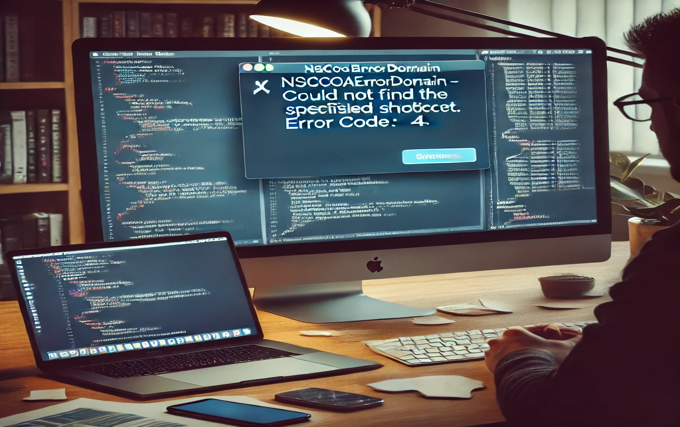In the ever-evolving landscape of macOS development, developers often encounter various errors that can disrupt their workflow and hinder application performance. One such error is characterized by the message: errordomain=nscocoaerrordomain&errormessage=could not find the specified shortcut.&errorcode=4. This error, while frustrating, provides valuable insights into potential issues with the app’s interaction with macOS features, particularly those involving shortcuts. In this article, we will delve into the details of this error, explore its implications, and provide practical solutions to address it.
What is NSCocoaErrorDomain?
To understand the error in question, we first need to explore what NSCocoaErrorDomain is. In macOS and iOS development, Cocoa is the native object-oriented API for applications running on the Cocoa platform. It provides a rich framework for building applications, integrating with system features, and handling user interactions.
Definition and Importance
NSCocoaErrorDomain is a constant used in the Cocoa framework that defines a specific domain for errors. This domain helps categorize errors generated by Cocoa APIs, allowing developers to manage and troubleshoot issues more effectively. Errors within this domain can stem from various sources, including file handling, network requests, user permissions, and, as we will focus on, issues with shortcuts.

Decoding the Error Message
The error message we are investigating can be broken down into several components:
- Error Domain:
nscocoaerrordomainindicates that the error originates from the Cocoa framework. - Error Message:
could not find the specified shortcutsuggests that the application is attempting to access a shortcut that does not exist or is not available. - Error Code:
4represents a specific error code associated with the missing shortcut.
Understanding Error Code 4
In the context of NSCocoaErrorDomain, error code 4 generally corresponds to an “item not found” scenario. This could occur for various reasons, including:
- The shortcut may have been deleted or moved.
- The application does not have the necessary permissions to access the shortcut.
- There may be a temporary glitch or corruption in the shortcut database.
Common Scenarios Leading to This Error
Understanding the scenarios that lead to this error can help developers diagnose and resolve the issue efficiently. Here are some common situations where this error might occur:
1. Deleted or Moved Shortcuts
Users often modify their shortcuts, including creating, deleting, or moving them around. If your application relies on a specific shortcut that has been removed or relocated, it will trigger the error.
2. Permissions Issues
macOS has stringent security measures in place to protect user data. If your application does not have the required permissions to access certain resources, including shortcuts, it may result in this error.
3. Corrupt Shortcut Database
Occasionally, the database that stores shortcut information may become corrupted. This could lead to inconsistencies, causing the application to fail when attempting to access a shortcut.
4. OS Version Compatibility
With every new macOS update, certain features and APIs may change or be deprecated. If your application is not updated to accommodate these changes, it may encounter errors when accessing shortcuts that were previously available.

Troubleshooting the Error
Now that we understand the nature of the error, let’s explore some practical solutions to resolve it.
Step 1: Verify Shortcut Existence
The first step in troubleshooting is to confirm whether the shortcut in question still exists. Here’s how you can check:
- Open the Shortcuts App: Launch the Shortcuts app on your macOS device.
- Search for the Shortcut: Use the search functionality to locate the shortcut by name.
- Check Shortcut Location: If the shortcut exists, ensure that it is in the expected location.
If the shortcut is missing, you may need to create it anew or update your application logic to handle its absence gracefully.
Step 2: Check Permissions
If the shortcut exists but your application still encounters the error, check the permissions:
- System Preferences: Navigate to System Preferences > Security & Privacy > Privacy.
- Accessibility: Ensure your application is listed and checked under Accessibility.
- Automation: If your app needs to control other apps, check the Automation section to ensure proper permissions are granted.
If permissions are not set correctly, modify them and test the application again.
Step 3: Reset Shortcuts Database
In some cases, resetting the shortcuts database may resolve corruption issues. Follow these steps:
- Close the Shortcuts App: Ensure the Shortcuts app is not running.
- Delete Preferences: Navigate to
~/Library/Preferences/and locate the preferences related to the Shortcuts app (typically namedcom.apple.shortcuts.plist). Move this file to the Trash. - Reopen the Shortcuts App: Launch the Shortcuts app again. The system should recreate the preferences file, effectively resetting the database.
Step 4: Update macOS and Application
Ensure both your macOS and the application are up-to-date. Check for updates:
- macOS: Go to System Preferences > Software Update to check for macOS updates.
- Application: If you are developing the application, ensure you are using the latest version of Xcode and any relevant SDKs.
Updating both can help avoid compatibility issues and leverage new features.
Step 5: Debugging and Logging
Incorporate robust error handling and logging within your application. This will help you capture detailed error information when the error occurs. Use the following strategies:
- NSError Objects: When handling shortcuts, check the NSError objects returned by relevant methods. Log the error domain, code, and message to gain more insights.
- Debugging Tools: Use Xcode’s debugging tools to step through the code and identify the exact point of failure.
Step 6: Seek Community and Apple Support
If the issue persists, consider seeking help from developer communities such as Stack Overflow or Apple Developer Forums. Many developers share their experiences and solutions to similar problems, which can provide valuable insights.
Preventing Future Errors
To minimize the chances of encountering the errordomain=nscocoaerrordomain&errormessage=could not find the specified shortcut.&errorcode=4 error in the future, consider implementing the following best practices:
1. Validate Shortcut Availability
Before attempting to access a shortcut, validate its existence programmatically. Use methods provided by the Shortcuts framework to check if the shortcut is available.
2. Graceful Error Handling
Incorporate error handling routines that can gracefully manage missing shortcuts. Provide users with informative feedback and potential solutions rather than crashing the application.
3. User Documentation
Educate your users about the importance of maintaining shortcuts and how to troubleshoot common issues. Clear documentation can empower users to resolve simple problems independently.
4. Regular Testing
Perform regular testing of your application, especially after system updates. Ensure that all features, including shortcut functionalities, work as intended across different macOS versions.
5. Utilize Analytics
Implement analytics to track how often users encounter this error. Understanding its frequency can help prioritize fixes and improve the overall user experience.

Conclusion
The error errordomain=nscocoaerrordomain&errormessage=could not find the specified shortcut.&errorcode=4 highlights potential issues in macOS development, particularly related to shortcut accessibility. By understanding its context and common triggers, developers can effectively troubleshoot and resolve this error. Implementing best practices such as validating shortcut existence, ensuring proper permissions, and maintaining robust error handling can significantly enhance application stability. Staying updated with macOS changes and engaging with developer communities further empowers developers to navigate challenges and deliver a seamless user experience, turning obstacles into opportunities for improvement in their applications.


